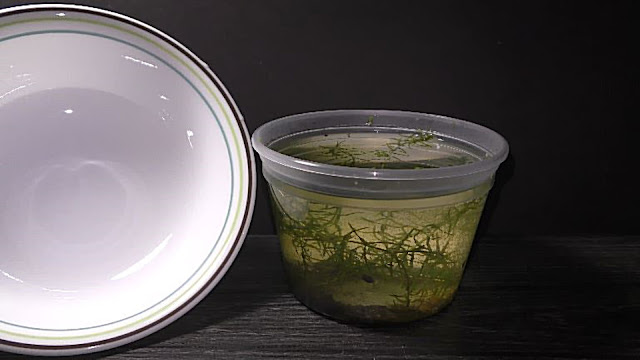June 23rd, 2021
You can buy Blackworms on Amazon:
A couple minutes ago, I finished a live stream about Duckweed found here.
And here I spotted some aquatic worms while I was talking about Duckweed.
You can see them waving their tails to me...right here.
Those could be Blackworms or tubifex among worms that I know.
And I actually have Blackworms in all my aquariums - fish love them!
I want to get samples of the worms.
Fill up a plastic bottle with water from the pond.
I wish I had some mesh to catch the worms...
Well, I am going to use what I have - my hands.
Take a handful of dirt along with worms.
Put it on a rock here.
And now let's dig gently through dirt looking for the worms.
I found one - put it in a bottle.
Put some water on the dirt if it's too dry.
Here I found another worm.
Blackworms have distinguishable behavior and abilities to reproduce from cuttings.
Whether I found blackworms or tubifex - they all are a great catch for my sustainable aquariums.
So, digging through one scoop of mud here I found about half a dozen worms.
Great. That is the simplest way to catch aquatic worms.
Here is a close up view of my worms.
Another way to catch all kinds of tiny aquatic critters is to get aquatic plants.
One never can be sure what critters may come with plants.
Here I pick guppy grass and...some unknown to me plant.
Let's put it all in the bottle with worms.
At home, I put the samples into two separate nurseries for quarantine.
The unknown plant with some critters goes into a 1 liter jar.
I see bladder snails, seed shrimp, cyclopes, and daphnia get caught in this sample.
There are many strings of filamentous algae.
I will not put this into my main aquariums.
And the worms are going into this 16oz plastic jar.
Take a closer look on the worms.
Now let's add the Guppy grass plant in this nursery.
Add dechlorinated water to the level.
And also, I like to add some some green algae aged water.
And a small pinch of homemade fish food flakes for worms to feed on.
Cover the nursery to reduce water evaporation.
Six days later on June 29th.
I took another look on critters in the 1 liter nursery.
And surely, I found more worms here.
Here is one.
Stirring water helps to find critters - most critters tend to swim against the current.
Let me move the plants out of the way.
Blackworms move differently depending on which part of their body we touch.
Let me demonstrate it to you.
Also, I speed up the video playback 3 times to make it more visible.
Now I am going to put all the worms, snails, and seed shrimp in the 16oz nursery.
I already know how well Blackworms breed in larger aquariums.
You can check it in my previous videos about Blackworms.
Now I want to check how Blackworms will breed in a small nursery of this size.
Let's add more aged water.
Also, I add some gravel to facilitate Blackworms fragmentation.
Fragmentation is the primary way Blackworms populate in Nature and in aquariums as well.
I keep this nursery with Blackworms on the same shelf I keep my other sustainable aquariums.
All my aquariums get only indirect sunlight.
No filters, no pumps, no water changes.
Three times a week, I feed a pinch of fish food flakes made of what growth in my aquariums.
The same way I feed my fish.
Keep the nursery covered to reduce water evaporation.
3 months fast forward you can see the nursery on September 16th.
There are deposits of green algae on the walls.
The water is clear.
Snails and seed shrimp has been doing fine - they are always fine even in smaller aquariums.
Let's pull some water from the bottom to check on the worms.
Okay, I think that should be enough...there is no point of picking all the dirt.
Let's take a closer look at what we have here.
It's easy to spot worms by the movements of the dirt where they are.
There are a lot of worms!
And all of them are small - about 1 cm or less.
That is a valuable observation to keep in mind.
Blackworms grow smaller in aquariums than they grow in Nature.
And they grow even smaller in small aquariums.
There is no point of keeping this culture in a such small nursery.
I move worms into 3 liter aquariums where I breed my dwarf guppies.
Worms will find here plenty of fish food leftovers to feed on.
And fish will catch and eat some of the worms.
In this regard, Blackworms are a perfect addition for sustainable aquariums.
And the rest of this nursery I split evenly among my other aquariums.
It takes just one Blackworm to establish a new colony of worms into any aquarium.
And remember to look at your local ponds during worm season to find Blackworms for your aquariums.
Have fun and happy aquarium gardens :)


































































































No comments:
Post a Comment